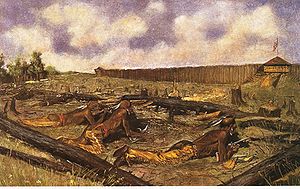- Siege of Fort Detroit
-
Siege of Fort Detroit Part of Pontiac's Rebellion 
The Siege of the Fort at Detroit by Frederic RemingtonDate May 9, 1763 – October 31, 1763 Location Near modern-day Detroit Result British victory Belligerents Pontiac's confederacy  Kingdom of Great Britain
Kingdom of Great BritainCommanders and leaders Pontiac
WassonHenry Gladwin
Donald Campbell †- For the action in the War of 1812, see the Siege of Detroit
The Siege of Fort Detroit was an ultimately unsuccessful attempt by North American Indians to capture Fort Detroit during Pontiac's Rebellion. The siege was led primarily by Pontiac, an Ottawa war leader.
Contents
Background
Fort Detroit had been captured by the British during the French and Indian War following the Fall of Montreal in 1760. It was on territory ceded by France to Great Britain in the Treaty of Paris in 1763 and was garrisoned by a British force when Pontiac's Rebellion in the wake of the war. .
Siege
On April 27, 1763, Pontiac spoke at a council about 10 miles (15 km) south of Detroit. Using the teachings of Neolin to inspire his listeners, Pontiac convinced a number of Ottawas, Ojibwas, Potawatomis, and Hurons to join him in an attempt to seize Fort Detroit and drive out the British.
On May 7, Pontiac entered the fort with about 300 men, armed with weapons hidden under blankets, determined to take the fort by surprise. However, the British commander Henry Gladwin had apparently been informed of Pontiac's plan, and the garrison of about 120 men was armed and ready.[1] Pontiac withdrew and, two days later, laid siege to the fort. A number of British soldiers and civilians in the area outside the fort were captured or killed;[2] one of the soldiers was ritually cannibalized, as was the custom in some Great Lakes Indian cultures. The violence was directed only at the British: French colonists were left alone. Eventually more than 900 Indian warriors from a half-dozen tribes joined the siege.
On May 28, a supply convoy commanded by Lieutenant Abraham Cuyler stopped at Point Pelee on its way to Detroit. Unaware of the ongoing siege, Cuyler and his men made camp without taking extra security precautions. About 200 Indians attacked, killing or capturing 61 of the 96 men of Cuyler's expedition. Those who escaped made their way to Fort Sandusky, but found it destroyed, and so they returned to Fort Niagara. The Indians took their captives to Detroit, where they were tortured and mutilated. The bodies were then tossed into the river to float by Fort Detroit, which undermined morale in the fort.
Late in July, 260 British reinforcements under the command of Captain James Dalyell arrived at Fort Detroit. On July 31, 1763, about 250 men attempted to make a surprise attack on Pontiac’s encampment. Pontiac was ready and waiting with over 400 warriors, and defeated the British at the Battle of Bloody Run.[3] However, the situation at the fort remained a stalemate, and Pontiac’s influence among his followers began to wane. Groups of Indians began to abandon the siege, some of them making peace with the British before departing. On October 31, 1763, finally convinced that the French in Illinois would not come to his aid, Pontiac lifted the siege and traveled south to the Maumee River, where he continued his efforts to rally resistance against the British.
Notes
- ^ Borneman, The French and Indian War, 286
- ^ Letter from former captive John Rutherfurd August 20, 1763 .pp.114-115
- ^ Borneman, The French and Indian War, 289
References
- Dixon, David. Never Come to Peace Again: Pontiac's Uprising and the Fate of the British Empire in North America. Norman: University of Oklahoma Press, 2005. ISBN 0-8061-3656-1.
- Dowd, Gregory Evans. War Under Heaven: Pontiac, the Indian Nations, & the British Empire. Johns Hopkins University Press, 2002. ISBN 0-8018-7079-8, ISBN 0-8018-7892-6 (paperback).
- Parkman, Francis. The Conspiracy of Pontiac and the Indian War after the Conquest of Canada. 2 volumes. Originally published Boston, 1851; revised 1870. Reprinted often, including Bison book edition: ISBN 0-8032-8733-X (vol 1); ISBN 0-8032-8737-2 (vol 2).
- Peckham, Howard H. Pontiac and the Indian Uprising. University of Chicago Press, 1947. ISBN 0-8143-2469-X.
- Borneman, Walter R. (2006). The French and Indian War. Harper-Collins Publishers. ISBN 978-0-06-076185-1.
Further reading
- Quaife, Milo Milton, ed. The Siege of Detroit in 1763: The Journal of Pontiac's Conspiracy, and John Rutherfurd's Narrative of a Captivity. Chicago: R. R. Donnelley, 1958.
- Richardson, John. Wacousta, or The Prophesy: A Tale of the Canadas. 1832. (a novelistic account of the siege).
External links
- "Chief Pontiac's siege of Detroit" - article from The Detroit News
Categories:- History of Detroit, Michigan
- Battles of Pontiac's War
- Sieges involving Great Britain
- Conflicts in 1763
- 1763 in North America
Wikimedia Foundation. 2010.
